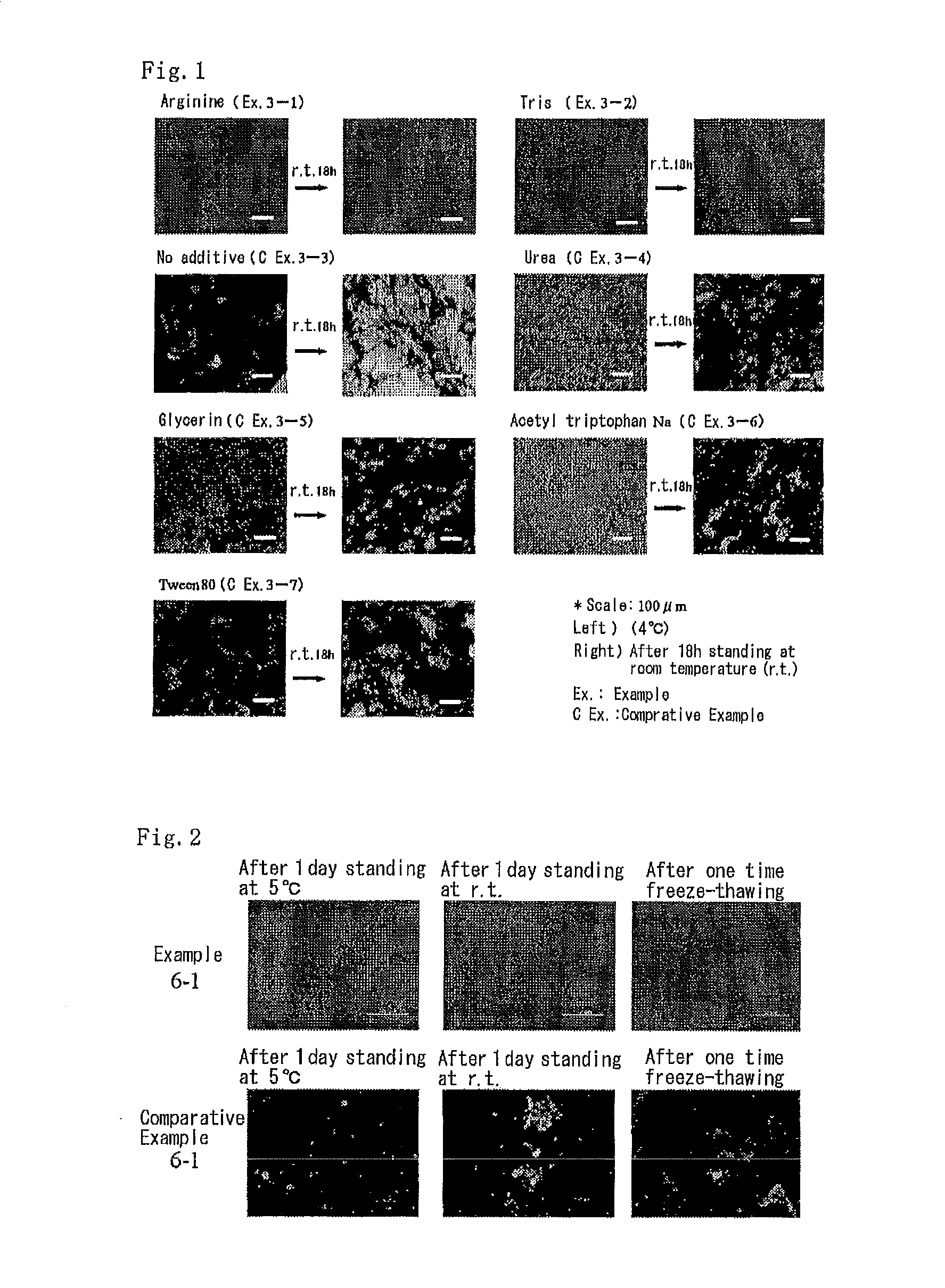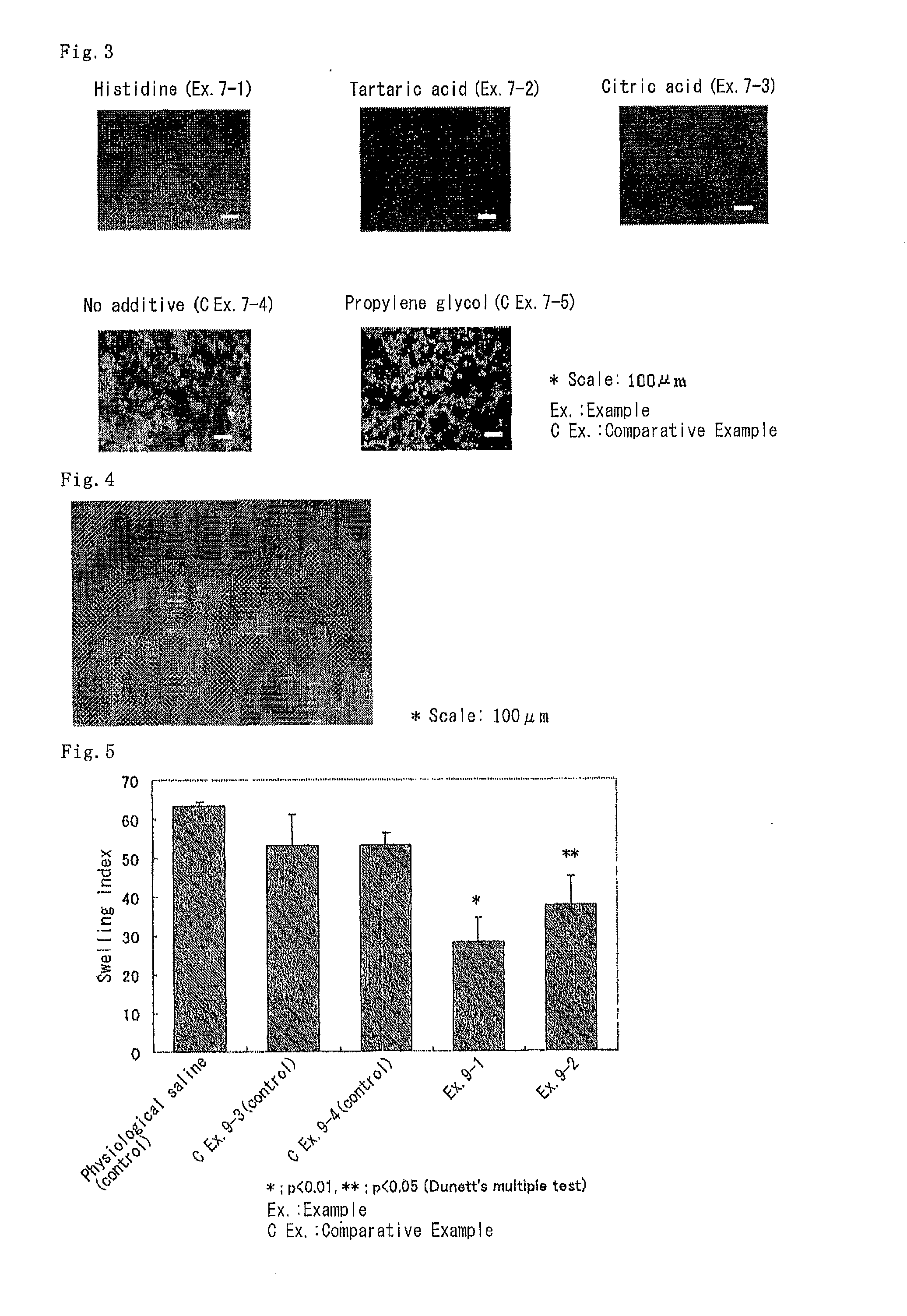Fine particulate preparation comprising complex of nucleic acid molecule and collagen
a technology of nucleic acid molecule and complex, which is applied in the direction of peptides, non-active genetic ingredients, drug compositions, etc., can solve the problems of low gene transfer efficiency to target cells, poor processing effect, and poor uniformity of dispersibility, so as to achieve uniform splendid dispersibility and maintain uniformity stably
- Summary
- Abstract
- Description
- Claims
- Application Information
AI Technical Summary
Benefits of technology
Problems solved by technology
Method used
Image
Examples
example 1
Microparticulation Effect of Arginine on Complexes of Oligonucleotide and Collagen
[0152]Complexes of collagen and antisense DNA were prepared by using arginine hydrochloride as an additive, a phosphorothioate antisense DNA having a sequence (5′-TGCATCCCCCAGGCCACCAT-3′, SEQ ID NO: 10) against a cell adhesion molecule mouse ICAM-1 as an oligonucleotide, and atelocollagen as a collagen (2% atelocollagen solution). They were mixed in PBS (pH 7.4) to the final concentration of 2% arginine, 0.1 mg / ml antisense DNA, and 0.05% collagen, and the mixture was allowed to stand overnight in a refrigerator (4° C.-10° C.) to obtain complexes of collagen and antisense DNA.
[0153]As a Comparative Example, complexes were prepared by mixing oligonucleotide and atelocollagen in a similar manner to the above except that arginine is not included.
[0154]In the same manner, complexes of the present invention and another Comparative Example were prepared using a phosphorothioate antisense DNA having a sequenc...
example 2
Microparticulation Effect of Various Additives on Complexes of Oligonucleotide and Collagen
[0158]Complexes were prepared by mixing a phosphorothioate antisense DNA against mouse ICAM-1 and atelocollagen in a neutral aqueous solution using an additive of the present invention, said additive being in the form of a hydrochloride or having been neutralized with various acids, and allowing the mixture to stand overnight in a refrigerator (4° C.-10° C.). The kinds of additives used and the final concentration of respective ingredients are summarized in Table 2.
[0159]To the respective samples was added single-stranded nucleic acid fluorescence staining regent YOYO (Molecular Probes) in order to stain the antisense DNA, and the samples were observed by fluorescent microscopy. Particles of greater than several μm can be discriminated by fluorescent microscopy. Every Examples gave uniform staining profile, and no particles exceeding 10 μm were observed.
TABLE 2Salt of additiveKind ofSampleKind...
example 3
Inhibitory Effect of Various Additives on Aggregation of Fine Particulate Complexes in Relation to Temperature
[0160]As an additive, arginine or trometamol was used, wherein the former was used in the form of hydrochloride and the latter was used after neutralization with hydrochloric acid. Complexes were prepared by mixing the additive, a phosphorothioate antisense DNA against mouse ICAM-1 as an oligonucleotide, and atelocollagen in neutral 0.1M phosphate buffer (pH 6.5-7.9) to the final concentration of 2%, 0.125 mg / ml, and 0.3%, respectively, and allowing the mixture to stand in a refrigerator (4° C.-10° C.) for two days. As Comparative Examples, complexes were prepared in the same manner except that additive is not included, or urea (denaturant and solubilizing agent of protein), glycerin (glycerol, typical fiber disassembly agent of collagen disclosed in the Patent document 4), acetyl tryptophan Na (stabilizing agent of protein), or Tween 80 (surfactant) is selected and used. Th...
PUM
| Property | Measurement | Unit |
|---|---|---|
| size | aaaaa | aaaaa |
| diameter | aaaaa | aaaaa |
| size | aaaaa | aaaaa |
Abstract
Description
Claims
Application Information
 Login to View More
Login to View More - R&D
- Intellectual Property
- Life Sciences
- Materials
- Tech Scout
- Unparalleled Data Quality
- Higher Quality Content
- 60% Fewer Hallucinations
Browse by: Latest US Patents, China's latest patents, Technical Efficacy Thesaurus, Application Domain, Technology Topic, Popular Technical Reports.
© 2025 PatSnap. All rights reserved.Legal|Privacy policy|Modern Slavery Act Transparency Statement|Sitemap|About US| Contact US: help@patsnap.com



